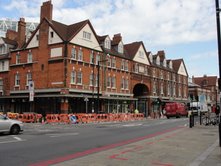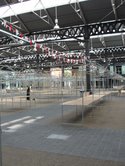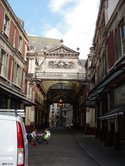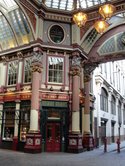Entries Tagged as 'Markets'

Walthamstow Market
This morning Megan, Mara, and Campbell set off for the Walthamstow Market in the center of Walthamstow Central. Walthamstow Market is the longest consecutive market in the city while by no means the largest. After exiting the train, we were immediately confronted by a large open grass field and a jumbo sized television screen in the center of the square. While this would mostly likely reflect a wealthy upscale neighborhood, the market itself targeted a more middle class to lower class clientele. The majority of people within the market were locals who knew to carry cloth bags or small carts to carry their purchases. This particular market did not cater to tourists, and many of customers were also regulars at produce stalls and small markets. Most items were priced no higher than 8 pounds. The merchants ranged from Cockney to Afro-Caribbean to Middle Eastern. The customers were mainly older women accompanied by young children or older husbands. The market itself is one wide street with stores along both sides and then a center aisle lined with stalls.

Market Stands
The stalls housed “fruit and veg” stands, leather goods, key cutters, clothing, toys, house wares, and fabric. Several of the stalls carried the exact same goods. There was a noticeable difference between the beginning of the street and the end of the market. Towards the front, closest to the bus and train stations, the quality of produce was better and the people running the stalls were mostly white British and then as we walked to the end of the market it became more ethnic. As we progressed, we began to notice the store fronts lining the market were not very well maintained. In the market itself there were a few cafes and food stands, including a rotisserie chicken stand, but the real food was found at the International Food Festival held at the forefront of the market.

Megan rides the kiddie rocket
The food ranged from Asian to German to Latin American, and after sampling goods from several stalls, we found that all the food offered there was exceptional. There were homemade breads and nice cheeses, as well as authentic sausage and even paella. The festival also had several children’s rides, including carousels, rocket ships, and a moon bounce. Megan found the rocket ships to be particularly exciting. The food festival attracted a number of families and couples, and for the first time since arriving in Walthamstow we discovered tourists among the locals.
If you would like to view more photos of the Walthamstow Market or the International Food Festival, please view our slide show: http://s644.photobucket.com/albums/uu163/mliberty2011/Walthamstow%20Market%20Place/?albumview=slideshow
Tags: Campbell · Mara · Markets · Megan
We left the Arran House bright and early at 8am. Together, we boarded the tube and set off for East Aldgate in search of the Whitechapel Market. This proved to be much more of a hassle than we had imagined. As we left the station and entered the streets of Whitechapel, our first perception of the area was the large, pristine East London Mosque, featured below.

From that moment on, we observed many bilingual street signs (in Arabic and English) and small family owned businesses including flower shops, restauraunts, and news agents.

Though there were a plethora of shops, there was a distinct lack of people. We were perplexed by the quiet streets and closed stores and were still unable to locate the elusive Whitechapel Market. Thankfully, a mailman was able to calm our fears…by telling us that it did not exist. He instructed us to walk a few blocks to Commercial Street where we could visit Spitalfields, a predominantly Islamic market. This also proved to be a disaster: it was closed, as we later found out from Professor Qualls, due to the beginning of Ramadan. Below are a few pictures of the deserted market which we imagined, under different circumstances, would otherwise be a vibrant and exciting community.

This is the exterior of the Spitalfield Market!

Here is the interior of the deserted market.
After another panicked call to Professor Qualls, he then directed us to Leadenhall Market which we located on the outskirts of London Proper. Originally a market for fish and cheese mongers, it was established in 1321 as a meeting place for vendors. However in 1666, parts of the original building were destroyed by the Great Fire and then later rebuilt in both 1881 and refurbished in 1990.

This is the entrance into the Leadenhall Markets.
Below is an image that captures the amazing architecture of the market place which is clearly incredibly ornate and a far cry from what we saw in Whitechapel. Not only were there high-end retail stores, but also high-rises and the buildings and streets were noticeably cleaner.

Here is an example of Leadenhall Market's interior!
Despite the fact that the markets were closed, it was still a very enlightening experience, for we saw two different Londons. The first being a predominantly immigrant community that combined the traditional culture of their homelands with the western ideals of Britain. The second was a more commercialized section of the city and felt more like a mainstream city center. It lacked, however, the intimate nature of Whitechapel. All in all, this experience helped us realize the economic and cultural diversity of London!
Tags: Kelley · Kimberly · Maddie · Markets
August 22nd, 2009 · 1 Comment

Outisde the Apple Market
Although it has only been two days, we were beginning to become a little skeptical of A.N. Wilson’s portrayal of a London overrun by American corporations and solely meant for tourism. All of the places that were not already tourist attractions were certainly un-American, and the cuisine was not only worldly but also a surprising amount of fusion food available (Indian/Japanese anyone?). However, after visiting the Covent Garden Market, we caught a glimpse of the England that was made for the tourist. The market is best described as a market for those who want to buy foreign things, but not too foreign. In the Jubilee Market, the shops almost entirely consisted of souvenir and novelty stalls.

A Keychain Shop
People visiting were welcomed to buy everything from London t-shirts, to calendars of David Beckham, and even London-themed condoms (“Want to see Big Ben?”). For those who didn’t have the local currency, there were numerous exchange agents and even stores that accepted American dollars and Euros.
The Apple Market was located in a 12th century abbey where the local monks would grow and sell their vegetables. Keeping in the tradition, there were a variety of chain stores, t-shirt vendors and cafes (The one fruit stand was not even located in the market, but outside one of the entrances).
Of the two markets, Apple seemed to consist more of permanent establishments, however Apple Market’s aim was no different from Jubilee in its desire to attract foreigners, with a welcome sign in several different languages, albeit slightly higher quality.
The surrounding neighborhood also played towards the same theme of tourism, with only the most popular chain retailers lining the streets such as Gap, The Disney Store, Starbucks, H&M, and others. The local theaters were mostly playing shows that had previously or were still on Broadway. Across from the market was the St. Paul’s Church but it was unfortunately closed at the time we were there.

St. Paul's Church
Slightly disillusioned by the cookie-cutter appeal of the Covent Garden area, we decided to walk back to the hotel. It took fifteen minutes of walking until the number of major chain retailers began to decrease and we began to see independent businesses (and pubs!).
The market clearly recognized that this was the type of London that tourists both expected and wanted to see. The shops were easily recognizable, the streets were clean, the vendor made sure that you knew that what you were buying was foreign, and everyone was white.

American Fare
Tags: Markets · Paul · Rebecca · Sarah
I love UNESCO world heritage sites and am thrilled to be able to count Maritime Greenwich among those I have visited! I honestly didn’t know what to expect before going to Greenwich this morning. I knew that there was an observatory, which meant that there was at least one really big hill, and the Prime Meridian, which my mother had requested I take a video of myself dancing on (yes, I did and it’s a long story).
What struck me first at the observatory was the practical elegance of the buildings. The original observatory, designed by Christopher Wren, had a beautifully decorated dome that was perfect for viewing the sky, but it also had the necessary living quarters for the Royal Astronomer. My favorite exhibit in the observatory museum was of the clocks. I found it really interesting to see the progress of clocks over time and the timepieces used in specific jobs to this day (ex. the diver watch and the Underground/Bus driver clock). I didn’t know that wristwatches were seen as feminine before WWI, but were found to be more practical in the trenches, causing men to adapt them.
After lunch, Chelsea and I headed over to the Maritime Museum and spent a fair bit of time wandering around the exhibits. In one of the rooms there was a really neat display that showed Butler’s Wharf (which we passed on the boat) as it was in 1937 and then again in 1997. It was very clear to see the development that happened over that 60 year span. In 1937 it was a heavily worked dock and warehouse area, while in 1997 it had been converted to luxury apartments. That display illustrated the expansion of the upper-middle class city into what had been a very working class area.
One of the other rooms in the Maritime Museum that I found fascinating was the reconstructed stained glass from the Baltic Club. The Baltic Club was a high-end club in the center of London and it was bombed in 1992. This exhibit showed the damage that had been done to the windows and what the conservationists had to do in order to restore them to their original state.
Greenwich Market was a curious place. It had just about everyone and everything you can think of: different languages being spoken, ethnic crafts, clocks made out of vinyl records, jewelry, lots of soap/incense places, and, of course, food. It didn’t take me too long to get through the market, but it was very charming. After the market, Chelsea and I, after much searching and walking, managed to find a 188 bus stop that was not closed for construction. Neither of us had really been on a bus in London, so we figured it was as good a time as any to figure out the system. A very long bus ride later, we got the Russell Square and made our way back to the hotel.
Tags: Kelley · Markets · Museums














